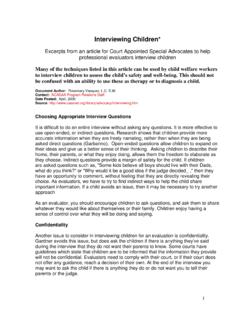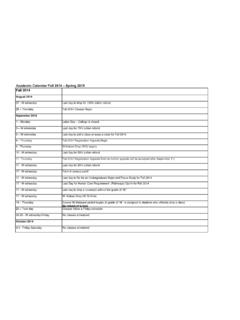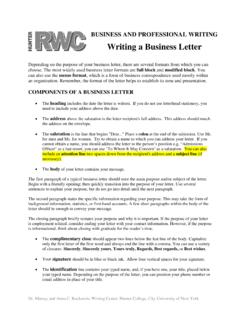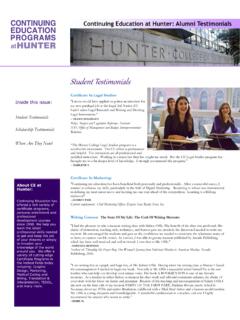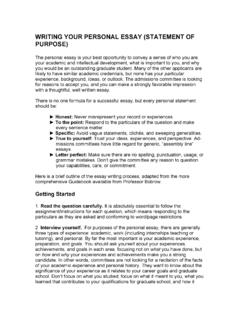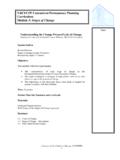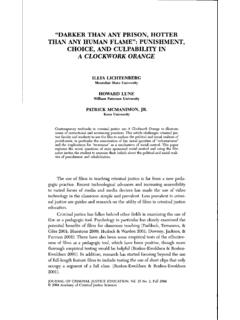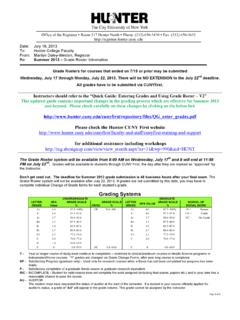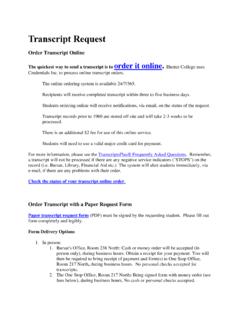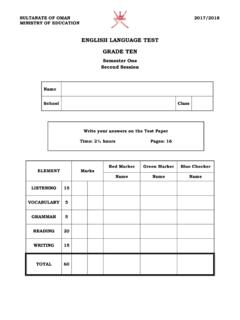Transcription of QUALITIES OF EFFECTIVE TEACHERS
1 QUALITIES OF EFFECTIVE TEACHERS . James Stronge The positive and negative behaviors exhibited by TEACHERS determine, to a great extent, their effectiveness in the classroom and, ultimately, the impact they have on student achievement. Several specific characteristics of teacher responsibilities and behaviors that contribute directly to EFFECTIVE teaching are listed for each of the following categories: The teacher as a person Classroom management and organization Organizing and orienting for instruction Implementing instruction Monitoring student progress and potential Professionalism Red flags signaling ineffective teaching are presented at the end of each section. Both positive and negative characteristics are based on a plethora of research-based studies that address the concept of improving the educational system for both students and TEACHERS .
2 These QUALITIES are general for any content area or grade level. Subject-specific QUALITIES presented for the four content areas typically found in all schools include: English History and Social Studies Mathematics Science The lists are provided as a vehicle to promote teacher effectiveness. I. THE TEACHER AS A PERSON. The teacher is the representative of the content and the school. How a teacher presents himself makes an impression on administrators, colleagues, parents, and students. Often a student links the preference to a particular subject to a teacher and the way the subject was taught. A teacher who exudes enthusiasm and competence for a content area may transfer those feelings to the students. In addition, how the teacher relates to the pupils has an impact on the students'.
3 Experience in the class. The teacher's personality is one of the first sets of characteristics to look for in an EFFECTIVE teacher. Many aspects of EFFECTIVE teaching can be cultivated, but it is difficult to effect change in an individual's personality. A. Positive QUALITIES Assumes ownership for the classroom and the students' success Uses personal experiences as examples in teaching Understands feelings of students Communicates clearly Admits to mistakes and corrects them immediately Thinks about and reflects on practice Displays a sense of humor Dresses appropriately for the position Maintains confidential trust and respect Is structured, yet flexible and spontaneous Is responsive to situations and students' needs Enjoys teaching and expects students to enjoy learning Looks for the win-win solution in conflict situations Listens attentively to student questions and comments.
4 Responds to students with respect, even in difficult situations Communicates high expectations consistently Conducts one-on-one conversations with students Treats students equally and fairly Has positive dialogue and interactions with students outside the classroom Invests time with single students or small groups of students outside the classroom Maintains a professional manner at all times Addresses students by name Speaks in an appropriate tone and volume Works actively with students B. Red Flags of Ineffective Teaching Believes that teaching is just a job Arrives late to school and class on a regular basis Has classroom discipline problems Is not sensitive to a student's culture or heritage Expresses bias (positive or negative) with regard to students Works on paperwork during class rather than working with students Has parents complaining about what is going on in the classroom Uses inappropriate language Demeans or ridicules students Exhibits defensive behavior for no apparent reason Is confrontational with students Lacks conflict resolution skills Does not accept responsibility for what occurs in the classroom II.
5 CLASSROM MANAGEMENT AND ORGANIZATION. A classroom reveals telltale signs of its user's style. Typically, a well-organized classroom has various instructional organizers, such as rules, posted on walls. Books and supplies are organized so that often needed ones are easily accessible. The furniture arrangement and classroom displays often reveal how the teacher uses the space. Once the students enter, the details of a classroom at work are evident. The teacher's plan for the environment, both the organization of the classroom and of students, allows the classroom to run itself amid the buzz of student and teacher interaction. A. Positive QUALITIES Positions chairs in groups or around tables to promote interaction Manages classroom procedures to facilitate smooth transitions, instructional groups, procurement of materials and supplies, and supervision of volunteers and paraprofessionals in the classroom Manages student behavior through clear expectations and firm and consistent responses to student actions Maintains a physical environment where instructional materials and equipment are in good repair Covers walls with student work, student made signs, memos.
6 And calendars of student events Has students welcome visitors and observers and explain activities Emphasizes students addressing one another in a positive and respectful manner Encourages interactions and allows low hum of conversations about activities or tasks Maximizes the physical aspect of the environment Manages emergency situations as they occur Maintains acceptable personal work space Establishes routines for the running of the classroom and the handling of routine student needs ( , bathroom visits, pencil sharpening, and throwing away trash). Provides positive reinforcement and feedback Disciplines students with dignity and respect Shows evidence of established student routines for responsibilities and student leadership Exhibits consistency in management style Posts classroom and school rules Posts appropriate safety procedures A.
7 Red Flags of Ineffective Teaching Arranges desks and chairs in rows facing forward (without regrouping). Displays inconsistencies in enforcing class, school, and district rules Is not prepared with responses to common issues (bathroom visits, pencil sharpening, and disruptions). Uses strictly commercial posters to decorate walls Lists rules and consequences for negative behaviors (teacher formulated). Ranks student progress on charts for all to view Emphasizes facts and correct answers Assigns one task to be completed by all students Does not post or is not clear about expectations of students Does not display school or classroom rules Allows student disengagement from learning Is unavailable outside of class for students Complains inappropriately about all the administrative details that must be done before class begins Maintains an unsafe environment or equipment Students have no specific routines or responsibilities Keeps an unclean or disorderly classroom Uses many discipline referrals Makes up rules and consequences or punishment according to mood.
8 Unpredictable Does not start class immediately, takes roll and dallies III. ORGANIZING AND ORIENTING FOR INSTRUCTION. Some TEACHERS plan at home, and others work after school, crafting unit plans that incorporate various objectives. Regardless where or how TEACHERS plan and organize for instruction, the evidence of EFFECTIVE work is seen in the classroom. An observer in the classroom of an EFFECTIVE teacher can quickly understand the work by viewing the daily lesson objectives and activities posted. Further, the teacher is able to share what the class will be doing to follow-up the lesson of the day. In many schools, TEACHERS are required to submit weekly lesson plans, these plans typically note accommodations for different learning styles or needs, and the variety of instructional approaches that will be used.
9 It is important to note, however, that a lesson plan is not an end-all; it is merely a description of what should be occurring in the classroom. Thus, a good plan doesn't guarantee high- quality instruction, but a poor plan most certainly contributes to ineffective instruction. A. Positive QUALITIES Lesson plans are written for every school day Students know the daily plan because an agenda of objectives and activities is given Student assessment and diagnostic data are available Assessment data and pretest results are included in the preparation of lesson plans Student work samples are available and considered when writing lesson plans Lesson plans are aligned with division curriculum guides Teacher-developed assessments are aligned with curriculum guides State learning objectives are incorporated into lesson plans Lesson plans have clearly stated objectives Lesson plans include use of available materials Lesson plans include activities and strategies to engage students of various ability levels
10 Lesson plans address different learning modalities and styles Lesson plans include required accommodations for students with special needs State standards are posted in classroom Lesson plans include pacing information Lesson plans for a substitute or an emergency are located in an easily accessible area of the classroom containing all necessary information B. Red flags of Ineffective Teaching No (or very few) lesson plans are available Student assessment and diagnostic data are not available No connection between assessment data and lesson plans is evident No differentiated instruction is provided Lesson plans are not aligned with local or district curriculum guides State learning objectives are not incorporated into lesson plans Activities that are unrelated to the learning objective are selected No plans for or anticipation of potential problems Lesson plans mainly consist of text or worksheets Students are not engaged in learning Lesson plans do not address different learning styles of students Lesson plans do not reflect accommodations for students with special needs State standards are not posted in the classroom
